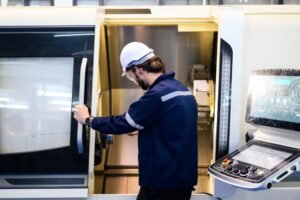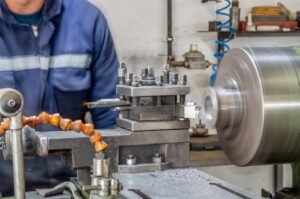Introduction
Manufacturers often face the challenge of producing components that are tiny, complex, and dimensionally critical—from surgical screws and aerospace connectors to watch gears no bigger than a grain of rice. For these parts, conventional lathes hit their limits.
Enter the Swiss-type lathe: a machine designed to make long, slender, and intricate parts with almost microscopic precision. Instead of fighting vibration and tool chatter, Swiss lathes practically eliminate it. This article walks you through how these machines work, why they’ve become indispensable, and where they deliver the most value.
History and Development
Swiss machining began in Switzerland’s watchmaking industry in the late 1800s, when watchmakers needed a way to cut extremely small gears and shafts. Jakob Schweizer’s 1870 solution was a lathe redesign incorporating a sliding headstock and guide bushing.This breakthrough stabilized the workpiece at the exact point of cutting.
The evolution since then has been dramatic:
- Early 20th century – Manual, cam-driven Swiss lathes powered much of the fine mechanics industry.
- 1970s–1980s – CNC controls transformed Swiss machines, adding programmability and multi-axis flexibility.
- Today – A modern Swiss CNC lathe combines sub-spindles, live tooling, and automation, effectively becoming a one-stop factory in a box.
Case in point: A Minneapolis medical device firm reported cutting cycle times by 40% after migrating bone screw production to Swiss CNC machines, largely because secondary drilling and threading steps were eliminated (source: MMS Online).
How a Swiss Lathe Works
Sliding Headstock and Guide Bushing
The defining feature is the sliding headstock. Stock is propelled forward by the headstock and rigidly secured just millimeters from the tool’s cutting point via the guide bushing. This approach overcomes the most significant weakness in standard lathe operation: deflection.
Post-cutoff handling is enhanced by an integrated sub-spindle that secures the part. Imagine trying to carve a pencil while holding it by the eraser—the tip bends or snaps. Now imagine holding that pencil right at the point of carving—that’s the Swiss principle.
As a result:
- Long, thin workpieces can be machined without bending.
- Surface finish improves because tools cut without chatter.
- Tighter tolerances are maintained across the entire part length.
Spindle and Sub-Spindle
A typical Swiss lathe doesn’t stop at one spindle. Functions that were traditionally distributed across a lathe, milling machine, and drill press are consolidated into this single setup.
- The main spindle handles turning, grooving, and initial features.
- The sub-spindle performs secondary work—such as back-drilling, threading, or deburring—without needing a second setup.
This feature is more than a convenience. It ensures concentricity between features on both ends of a part, something that’s difficult when transferring parts between machines.
Live Tooling and Multi-Axis Control
Modern Swiss CNC machines can do more than turn. Live tooling—spindles mounted on turrets or gang slides—enable operations like milling flats, drilling cross-holes, and even engraving.
Many models boast 7–10 axes of motion, giving programmers the flexibility to combine operations into a single cycle.
Tutorial example: Consider a medical implant that needs both longitudinal grooves and precise side holes. In conventional machining, this would involve the use of three different machines: a lathe for turning, a mill for milling, and a drill press for drilling. A Swiss lathe with live tooling completes it in one continuous program, saving days of handling and setup.
Key Advantages
Swiss lathes aren’t just about bragging rights—they deliver measurable advantages:
- Unmatched precision: Tolerances of ±0.0002 in are routine, supporting industries like aerospace and medical where reliability is life-critical.
- Cycle time efficiency: By combining turning, milling, and drilling in one setup, shops often reduce lead times by 30–50%.
- Reduced labor cost: Automated bar feeders allow continuous “lights-out” production overnight.
- Versatility: Handles everything from titanium bone screws to plastic connector pins.
Case Study: An aerospace supplier cut production costs by 25% after adopting Swiss CNC machines. Producing 20,000 miniature connectors in a single unattended shift was suddenly feasible—something impossible with older setups.
Challenges and Limitations
Swiss lathes aren’t without trade-offs:
- Setup complexity: Programming multi-axis movements requires experience and can be intimidating for new operators.
- Strict material requirements: Bar stock must meet tight diameter tolerances to pass smoothly through the guide bushing.
- High initial cost: Machines often start above $150,000, with tooling adding significantly to the investment.
- Skilled labor demand: Operators must understand timing, synchronization, and tool offsets across multiple spindles.
Operator insight: On the Practical Machinist forum, one veteran noted it took him six months of daily use to feel comfortable with his first Swiss CNC—mainly due to the complexity of managing overlapping tool paths.




